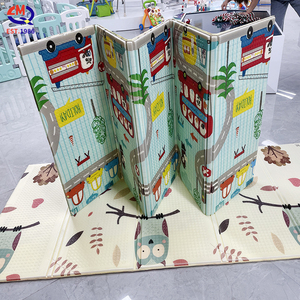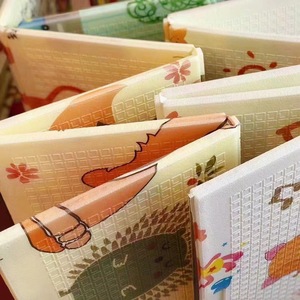(14969 products available)












































































































































































































































A foam play mat for babies comes in various types, each designed to meet different needs and preferences. Here are some common types:
Standard Foam Play Mats
These are the most common types. They are manufactured using lightweight and soft foam materials that provide cushioning for babies to play safely. They are often non-toxic and easy to clean.
Interlocking Foam Mats
These mats are produced as individual tiles that can be connected to form a larger surface. This offers customizable coverage to fit different spaces. They are ideal for growing toddlers since they provide a stable surface for playing and are easily replaceable if one of the tiles becomes damaged.
Activity Play Mats
These mats are commonly known as educational mats. They are accompanied by various printed activities, such as shapes, numbers, or scenes that promote interactive play. They are developed to encourage cognitive development and are usually fitted with textures and graphics that stimulate the senses.
Alphabet and Number Mats
These mats are specifically designed to educate young children by introducing them to letters and numbers. They are developed to make learning enjoyable and are usually colorful and engaging, making them perfect for early learners.
Travel Play Mats
These mats are portable and lightweight, making them easy to carry around. They are often foldable or rollable for convenient storage. They are great for families that are frequently on the move, as they provide a safe space for play when in a different location.
Waterproof Play Mats
These mats are delineated with a waterproof layer that makes them ideal for messy play or for use in areas where spills are likely to happen. They are easy to wipe down and keep clean.
When choosing a foam mat for babies, evaluate the material, thickness, size, safety, and design before placing an order.
Material
Foam mats are made from various materials, including polyethylene foam, EVA foam, and PU foam. Ethylene vinyl acetate (EVA) foam is the most popular material for foam play mats. It is a rubber-like material with a soft, non-toxic, and anti-slip surface. Polyethylene foam is lightweight, firmer, and more durable than EVA foam. It also has a moisture-wicking property. Polyurethane (PU) foam is softer and offers better cushioning. However, it is more expensive and may not be as durable as EVA and PE foams.
Thickness
The thickness of the foam play mat affects comfort and support. Thicker mats provide better cushioning, which is important for babies as they learn to crawl, roll over, and eventually stand up. A thicker mat also offers better insulation against cold floors. However, the mat should not be too thick, as it can make it harder for babies to balance and stability when engaging in various activities. Generally, a thickness of 1 to 2 inches is ideal.
Size
The mat's size should fit the available space and accommodate the baby's playing activities. Larger mats provide more space for the baby to play and move around. However, ensure the room has enough space for the mat to avoid cramping.
Safety
Safety is a top priority when choosing a foam play mat. The mat should be non-toxic and free from harmful chemicals like phthalates, BPA, and heavy metals. These substances can cause various health issues when ingested or absorbed through the skin. Choose a mat with a non-slip surface to prevent accidental falls.
Design
The mat's design and color are also important. A colorful mat with interesting patterns can stimulate a baby's visual senses. Choose a mat with engaging designs that can keep a baby entertained. Also, the mat should have educational features, like numbers and letters, to help a baby learn when they grow older.
Foam play mats for babies come in different designs, features, and functions. Below are some of them.
Foam play mats protect babies from injuries when they fall or accidentally knock over hard surfaces. They also provide a comfortable surface for tummy time, crawling, and playing. Moreover, they stimulate cognitive development through interactive elements and encourage physical activity.
Interactivity
Many foam mats have interactive features such as removable toys, zippers, and sound modules. Removable toys stimulate babies to play and keep them occupied. Zippers allow parents to detach portions of the mat for easy carrying and playing. Sound modules produce soothing sounds or music for the baby to enjoy.
Portability
Foam play mats are lightweight and easy to carry around. Many have handles for easier carrying. Some fold up small like a mat used in schools. They are perfect for traveling and visits to family and friends.
Washability
A washable foam mat is convenient because it is easy to maintain. Most play mats have a removable, machine-washable cover. Some have wipeable surfaces. The play mat becomes clean, fresh, and germ-free with every wash. This helps to keep the baby healthy and hygienic.
Colors and patterns
Foam play mats for babies come in vibrant colors and patterns. The colors stimulate visual development and make the mat attractive. Patterns can be in the form of shapes, animals, or nature. They add educational value and make the mat interesting.
Theme-based designs
These designs are inspired by specific themes like nature, cities, and the zoo. They create a playful environment where the baby can explore different settings.
Modular designs
These play mats are made of interlocking tiles that can be arranged in any shape or form. They are customizable and expandable to fit any space.
Safety and quality are the most crucial elements to consider when choosing a foam play mat because they directly impact the child's health and well-being. Therefore, parents should examine safety features and quality indicators to ensure they provide their baby with a secure and durable play mat.
Non-toxic materials
The foam play mat should be made from non-toxic materials. Parents should look for mats made from materials like natural rubber that are free from harmful chemicals like phthalates, BPA, and heavy metals. This reduces the risk of exposure to toxic substances, ensuring a safe space for the baby to play, crawl, and explore.
Certifications
Certifications from reputable organizations like the American Society for Testing and Materials (ASTM) or the Consumer Product Safety Improvement Act (CPSIA) indicate that the play mat has undergone rigorous safety testing and meets industry standards. These certifications give parents peace of mind, knowing the mat is safe for their children.
Durability
A durable play mat won't wear out quickly, ensuring the baby has a safe space for play for a long time. When choosing a durable mat, consider its thickness and quality of the material construction. A thick play mat will be more durable as it can withstand rough play without getting damaged. Additionally, a well-constructed mat won't lose its shape or cushioning over time, providing a consistently safe and comfortable surface for the baby.
Edge and corner safety
Rounded corners and soft edges on a foam play mat minimize the risk of injury during playtime. Sharp edges can cause cuts or bruises, while rounded corners help prevent accidents, making the mat safer for active and curious babies. Therefore, parents should choose a play mat with rounded corners and soft edges.
Q1: What thickness of foam mat is ideal for a baby?
A1: Usually, a 1-inch thick foam mat is recommended as it offers better cushioning and support for the baby. Thicker mats provide additional padding, which helps in absorbing impact and protecting joints during crawling, rolling, and other activities.
Q2: When should a baby start using a play mat?
A2: A baby can start using a play mat as soon as he or she is born. In this case, the play mat will offer a soft, padded surface for tummy time, which is essential for developing neck and shoulder muscles.
Q3: Are play mats washable?
A3: Yes, most play mats are washable. However, it's essential to check the manufacturer's instructions for each specific mat. Some can be machine washed, while others require spot cleaning or a damp cloth.
Q4: What should business buyers look for in a foam play mat for babies?
A4: Business buyers should consider the material, thickness, safety features, and design.